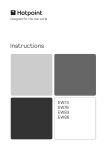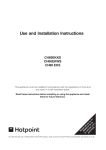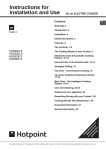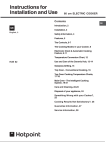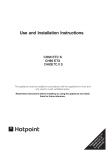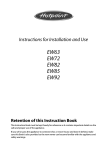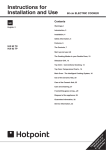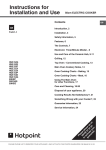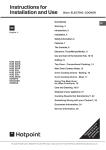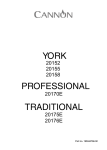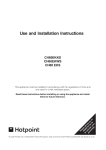Download Hotpoint EW84 Oven User Manual
Transcript
Instructions for Installation and Use 60cm slot-in double oven Electric cooker EW84 To the Installer: Before installation, fill in the product details on the back cover of this book. The information can be found on the rating plate. To the User: You must read the instructions prior to installing and using the appliance and then retain them for future reference. Contents Page Introduction 3 Installation 4 Safety Information 5-6 Features 7 The Controls 8-10 The Cooking Modes in your Cooker 11-12 Electronic Clock & Automatic Cooking Feature 13-16 Temperature Conversion Chart 17 Use and Care of the Ceramic Hob 18-20 Grilling 21-22 Top Oven – Conventional Cooking 23 Top Oven Cooking Temperature Charts 24-25 Main Oven – The Intelligent Cooking System 26 Main Oven Cooking Temperature Charts 27-29 Care and Cleaning 30-33 If something goes wrong / If it still won’t work 34 Hotpoint Service Cover 35 Key Contacts back page Retention of this Instruction Book This Instruction Book must be kept handy for reference as it contains important details on the safe and proper use of the appliance. If you sell or pass the appliance to someone else, or move house and leave it behind, make sure this Book is also provided so the new owner can become familiar with the appliance and safety warnings. 2 Introduction Your new appliance is guaranteed* and will give lasting service. This guarantee is only applicable if the appliance has been installed in accordance with the installation instructions detailed in this booklet. To help make best use of your cooking equipment, please read this booklet carefully. The cooker is designed specifically for domestic use and responsibility will not be accepted for use in any other installation. When the cooker is first used an odour may be emitted, this will cease after a period of use When first using the cooker ensure that the room is well ventilated (e.g. open a window or use an extractor fan) and that persons who may be sensitive to the odour avoid any fumes. It is suggested that any pets be removed from the room until the smell has ceased. This odour is due to temporary finish on oven liners and elements and also any moisture absorbed by the insulation. * The guarantee is subject to the provisions that the appliance: (a) (b) (c) (d) Has been used solely in accordance with the Users Instruction Book. Has been properly connected to a suitable supply voltage as stated on the rating plate attached to this equipment. Has not been subjected to misuse or accident or been modified or repaired by any person other than the authorised employee or agent. Has been correctly installed. This appliance conforms to the following EEC Directives: Electromagnetic Compatibility Low Voltage Equipment 89/336/EEC 73/23/EEC 92/31/EEC 93/68/EEC 93/68/EEC 3 Installation WARNING – THIS APPLIANCE MUST BE EARTHED. Mains Connection Your cooker should have been checked to ensure that the voltage corresponds with your supply voltage, this is stated on the rating plate, which is situated on the outer rear panel. The model number and serial number are located on the front of the cooker, as shown on the Feature’s page. The cooker must be connected by a competent person such as one who is a, NICEIC registered contractor to a suitable double-pole control unit with a minimum rating of 32A and a minimum contact clearance of 3mm (applicable to newer properties, older properties where a 30A double pole control unit and a minimum contact clearance of 3mm is acceptable). The double pole control unit should be fitted adjacent to the cooker, in accordance with IEE regulations. The control unit must be within 2 metres of but not directly above the appliance and should be easily accessible in the event of an emergency. The power supply cable should conform to B.S.6004 with a conductor size of 6mm2, minimum. Access to the mains terminals is gained by removing the rear access cover. The mains cable must pass through the cable clamp adjacent to the terminal block. Sufficient cable should be used to allow the cooker to be pulled out for servicing. Ensure that the mains cable is routed away from any brackets affixed to the rear panel and is not trapped to the rear wall when pushing the cooker into position between cabinets. Levelling Four feet are fitted which can be adjusted up or down to set the height (900mm - 930mm) and level the cooker. The feet can be simply screwed in or out to lower or raise the cooker. After the correct height is achieved, lock the feet into position by tightening the locking nut using an open ended spanner. CAUTION: Some soft floor coverings may get damaged if the cooker is not moved carefully. NOTE: Ensure oven shelves are level by using a spirit level on the rod shelves. Siting the Cooker The cooker is designed to fit between kitchen cabinets spaced 600mm apart. The space either side need only be sufficient to allow withdrawal of the cooker for servicing and cleaning. It can be used with cabinets one side or both as well as in an angled corner setting. It can also be used freestanding. Adjacent side walls which project above hob level, must not be nearer to the cooker than 150mm and should be protected by heat resistant material. Any overhanging surface or cooker hood should not be nearer than 650mm. Note: This appliance must NOT be fitted on a platform. Moving the Cooker Before moving your cooker, switch off at the cooker control unit, ensure that it is cool. Open the grill door sufficiently to allow a comfortable grip on the underside front edge of the oven roof, avoiding any grill elements. Radio Interference This appliance conforms to EN 55014 regarding suppression of radio and television interference. Note: Take care in moving the cooker as it is heavy. Take care to ensure that any floor covering is not damaged. 4 Safety Information When used properly your appliance is completely safe but as with any electrical product there are certain precautions that must be observed. PLEASE READ THE PRECAUTIONS BELOW BEFORE USING YOUR APPLIANCE. Always ● Remove all packing from the appliance before switching on for the first time. ● Understand the controls prior to using the appliance. ● Keep children away from the appliance when cooking as the surfaces will get extremely hot during and after use. ● Turn controls off when not in use. ● Stand back when opening an oven door to allow any build up of steam or heat to disperse. ● Always use dry good quality oven gloves when removing items from the oven/grill. ● Always place pans centrally over the hotplate making sure handles are kept away from the edge of the hob and cannot become heated by other hotplates or pans. ● Always take care to avoid heat or steam burns when operating the controls. ● Always turn off the electricity supply at the wall switch and allow the appliance to cool before cleaning (or changing an oven lamp if fitted). ● Always make sure the shelves are in the correct position before switching on the oven or grill. ● Always keep the oven/grill door closed when the appliance is not in use. ● Always keep the appliance clean as a build up of grease or fat from cooking can cause a fire. ● Always follow the basic principles of food handling and hygiene to prevent the possibility of bacterial growth. ● Always keep ventilation slots clear of obstructions. ● Always refer servicing to a qualified appliance service engineer. ● Always take care when removing items from the grill compartment when the lower oven is in use as the contents will be hot. ● Always turn off the electricity supply to the appliance at the wall switch should any glass panel (if fitted) crack or shatter and then DO NOT USE THE APPLIANCE until repaired. ● During use, the oven becomes hot. Care should be taken to avoid touching heating elements inside the oven. 5 Safety Information Never ● Never stare at Halogen heating units. ● Never leave children unsupervised where a cooking appliance is installed as all surfaces will be hot during and after its use. ● Never allow anyone to sit or stand on any part of the appliance. ● Never store items above the appliance that children may attempt to reach. ● Never leave anything on the hob surface when unattended and not in use. ● Never remove the oven shelves whilst the oven is hot. ● Never heat up unopened food containers as pressure can build up causing the container to burst. ● Never store chemicals/food stuffs or pressurised containers in or on the appliance, or in cabinets immediately above or next to the appliance. ● Never place flammable or plastic items on or near the hob. ● Never fill a deep fat frying pan more than 1/3 full of oil, or use a lid. DO NOT LEAVE DEEP FAT FRYING PANS UNATTENDED WHILE COOKING. ● Never use the appliance as a room heater. ● Never use the grill to warm plates. ● Never dry any items on either the hob or oven doors. ● Never install the appliance next to curtains or other soft furnishings. ● Never operate the grill with the grill door closed as this will cause the appliance to over heat. ● Never use ‘steam cleaners’. SAFETY ADVICE IN CASE OF A CHIP-PAN FIRE In the event of a chip pan fire or any other pan fire. 1. TURN OFF THE COOKER APPLIANCE AT THE WALL SWITCH. 2. COVER THE PAN WITH A FIRE BLANKET OR DAMP CLOTH, this will smother the flames and extinguish the fire. 3. LEAVE THE PAN TO COOL FOR AT LEAST 60 MINUTES BEFORE MOVING IT. Injuries are often caused by picking up a hot pan and rushing outside with it. NEVER USE A FIRE EXTINGUISHER TO PUT OUT A PAN FIRE as the force of the extinguisher is likely to tip the pan over. Never use water to extinguish oil or fat fires. 6 Features WARNING: DO NOT touch the oven doors when the oven is in use as these areas can become hot. 1800W Halogen Ceramic 1200W Ceramic 1500W Dual Oval Ceramic 1200W Ceramic Hob Hot indicators Timer Control panel Conventional Grill Oven Light Grill pan handle fixed/detachable Top Oven/Grill rod shelf Grill pan and food support ‘Stay Clean’ liners Top Oven door Removable Inner door glass Main Oven door Oven light Oven fan Door Switch ‘Stay Clean’ liners Main oven rod shelf Model number & Serial number label Main oven seal split at these corners Removable Inner door glass NOTE: To keep the controls cool when the appliance is used, a flow of air may be blown from beneath the control panel. If the appliance is still warm, this cooling fan will run on when all controls have been turned off. This is normal and is not a fault. The fan will stop once the appliance has cooled. NOTE: Children should not be allowed to play with the appliance or tamper with the controls. 7 The controls Switch on the electricity supply to the cooker at the Cooker Control Unit. Main Oven Control Top Oven Control Grill Control Timer Hob Controls Dual Circuit Oval Hotplate control Hob Controls As each control knob is turned clockwise, numbers from 1 - 6 on the control knob increase. Setting 6 is the highest/hottest and gives 100% power. Setting 1 is the lowest/coolest and gives about 7% power. Variable power is obtainable on each of the heating areas by selecting any number between 1 & 6. Right Front Control This is to control a dual circuit oval hotplate with two elements. By turning the knob clockwise both parts of the hotplate are switched on, numbers 1-4 on the control knob, 4 is the highest setting. With the knob turned anticlockwise, only the inner part of the hotplate is switched on, this is also indicated by numbers 1-4 on the control knob, 4 is the highest setting. Variable power for either the whole or the inner part of the hotplate is obtained by selecting any number between 1 & 4. The off position is identified by an ‘0’. The hob hot warning lights will operate soon after each of the heating areas have been switched on. Each warning light will remain illuminated until each heating area has cooled down. Main Oven Light The main oven light can be switched on, when the oven is not in use, by pressing the oven light button on the display. The oven light will also operate whenever the main oven door is opened. NOTE: The oven light can be switched off when the door is opened by pressing the oven light button on the display, or by closing the door. Cooling Fan The cooling fan operates with the ovens and grill. The fan will operate at full speed for a few seconds and then reduce to a lower speed. The cooling fan will only increase to full speed if the temperature inside the cooker reaches above a certain limit. 8 The controls continued... Main Oven Functions (1-7): 2.TRADITIONAL 4.ROAST CHICKEN 6.BREAD OVEN Grill control Main Oven: - Recommended Shelf Position and - Preheat Temperature Indicator Top Oven control Top Oven: - ‘ON’ Indicator and - Preheat Temperature Indicator 1.FAN OVEN 3.ROAST MEAT 5.FISH - + Main Oven Light 7.CAKES Main Oven Select control Set Time Time / Mode +/- Control Knob End Time Cooking Duration Minute Minder Grill Control Top Oven The grill control will not operate unless the top oven control is in the ‘O’ off position. The grill control provides fully variable heat control for either the twin grill or single (left hand side) grill by selecting any number between 1 & 4. When turned clockwise the twin grill will be switched on and any power setting from 1 - 4 can be selected. The power level numbers are indicated on the control knob. When turned anti-clockwise the single grill will be switched on and any power setting from 1 - 4 can be selected. The power level numbers are indicated on the control knob. The off position is identified by an ‘O’. Top Oven Control This control switches on the top and bottom heating elements in the top oven. The temperature in the oven can be set anywhere between 100˚C and 220˚C. The top oven ON indicator (TOP) and the top oven preheat temperature indicator ( symbol) will be on the display (bottom left hand corner). The top oven preheat temperature indicator ( symbol) will switch OFF and an audible tone will sound when the top oven has reached the required temperature. When in operation the oven light will be illuminated. The off position is identified by an ‘O’. Notes If both the top oven and grill controls are turned on together, the (TOP) and ( symbol) will flash on the display. The cooker will continue to operate in the function which was selected first. 9 The controls continued... Main Oven Control This control switches on the top and rear heating elements at various times in the main oven, dependent on which mode has been set. The temperature of the main oven can be set anywhere between 80˚C and 230˚C in cooking modes 1 - 5. The main oven preheat temperature indicator ( symbol) will be on the display (middle, left hand side). The main oven preheat temperature indicator ( symbol) will switch OFF and an audible tone will sound when the main oven has reached the required temperature. The Main Oven Cooking Functions The main oven has eight cooking functions. Use the main oven control to select the cooking mode you require. The display will show the function you have selected, across the top (1 - 7) with the eighth function being shown on the clock display as ‘(RISE)’. Adjusting the Main Oven Temperature When a program is set (position 1 - 5), the display will automatically suggest a cooking temperature. If you wish you can use the +/- control knob to change the suggested temperature to one of your own choice, within a range which is suitable for the particular cooking mode. 10 The Cooking Modes in your Cooker Your new cooker is equipped with a number of different cooking modes: Conventional Heating (Top Oven) - with upper and lower heat. This system is particularly suitable for roasting and baking on one shelf only. Variable Grilling (Top Oven) - the oven can also be used for conventional grilling with a full or half width fully controllable grill. Note: The Top Oven door should be open when grilling. Fan Oven (Main Oven) - the fan oven operates by constantly blowing heated air, from an element wrapped around the fan, into the oven. This gives improved efficiency and in general, enables the use of lower temperatures for cooking. It also means that there is less need to be particular about shelf positions and that you can bake at more than one level simultaneously (Batch Baking). Traditional (Main Oven) - the upper and rear heating elements are switched on in this position. The traditional oven brings an outstanding level of temperature distribution and reduced consumption. In traditional cooking use only one rack to ensure good heat distribution. By using the various shelf positions available you can balance the quantity of heat between the upper and lower part. If cooking requires more heat from below or above, use the lower or higher shelves respectively. Roast Meat (Main Oven) - specially created for cooking joints of meat. This mode raises the temperature in the oven to a very high heat for the first part of the cooking cycle, to seal the outside of the joint and retain the juices of the meat throughout cooking. After this the temperature is reduced to the set temperature using each heating element in turn to guarantee a homogeneous temperature for the cooking period. A temperature is suggested on this mode but this can be altered using the '+/-' control knob. Roast Chicken (Main Oven) - specially created for cooking excellent roast poultry. This mode can be used to roast chickens, duck, turkey and other poultry to perfection. Each heating element is used in the cycle to guarantee a homogeneous temperature within the oven. A temperature is suggested on this mode but this can be altered using the '+/-' control knob. 11 The Cooking Modes in your Cooker continued... Fish (Main Oven) - this mode provides gently pulsing top and rear heat to lightly poach fish dishes without overcooking or drying out. A temperature is suggested on this mode but this can be altered using the '+/-' control knob. Rising (Main Oven) - this mode heats and holds the oven at 40˚C. It is ideal for proving bread and yeast based dough mixtures. When this mode is selected a cooking duration of 14 minutes is automatically set, this can be altered by pressing the 'time/mode' button until the cooking duration icon flashes. Then use the '+/-' control knob to adjust the cooking duration. Bread cycle - Auto - this mode is fully automatic and lasts for 1 hour. When this mode is selected the time and temperature cannot be adjusted. It is suitable for baking bread weighing up to 1.5kg, either in a tin or on a baking tray. This mode includes a proving cycle and a baking cycle. If an initial proving cycle is needed this can be done using the RISE mode (8). Some recipe ideas are included in the recipe book supplied with the cooker. Cake cycle - Auto - this mode is fully automatic and lasts for 1 hour. When this mode is selected the time and temperature cannot be adjusted. it is suitable for baking sponge based cakes that take between 30 minutes and 1 hour to cook. Some recipe ideas are included in the recipe book supplied with the cooker. 12 Electronic Clock & Automatic Cooking Feature When you first switch on the appliance you will be prompted to set the ‘Time of Day’ on the display. You must ensure you have done this before attempting to use the automatic cooking feature. AUTOMATIC COOKING The main oven can be controlled automatically. HINTS ON AUTOMATIC - Select food which will require the same cooking time and temperature. - To ensure food does not cool down and require reheating, set the end COOKING time so the food is ready when you require it. - Always ensure that meat and poultry is defrosted before placing in the oven. - Whenever possible, take food out of the refrigerator and keep it as cool as possible. - If cooking food that requires frying before placing in the oven for automatic cooking, keep the delay time to a minimum. - Never place hot or warm food in the oven for delayed start cooking as it could cause the oven to be warm and produce harmful bacteria in the food. - We advise that dishes containing left-over cooked poultry and meat, eg. shepherds pie, should not be cooked automatically if there is to be a delay period. - Ensure that delay start times are kept to a minimum to prevent bacterial growth in food. - Wine or beer may ferment and cream may curdle during the delay period, so it is best to add these ingredients just before serving. - Foods which discolour should be protected by coating in fat or tossing in water to which lemon juice has been added, prior to placing food in the oven. - Dishes containing liquid should not be filled too full to prevent boiling over. - Food should be well sealed (but not airtight) in a container to prevent the loss of liquid during cooking. Aluminium foil gives a good seal. - Always ensure that food is piping hot and cooked thoroughly before serving. - Only reheat food once. SETTING THE TIME OF DAY: Main Oven Light STEP 1. Check the electricity supply to the cooker is turned on. STEP 2. When switched on the display will show both 00:00 and the ‘set time’ symbol flashing. Wait until these stop flashing. STEP 3. Press the Time/Mode button once, so that the ‘Set Time’ symbol and the display are flashing. Turn the +/- control knob until the correct hour is set. STEP 4. Press the Time/Mode button once, so that the ‘Set Time’ symbol and the display are flashing. Turn the +/- control knob until the correct minutes are set. Press the Time/Mode button again. Time/Mode - + TIME OF DAY IS NOW SET. To alter the time of day after the first setting, simply press the Time/Mode button. The ‘Set Time’ symbol and the display will flash. Repeat STEPS 3 and 4. 13 Electronic Clock & Automatic Cooking Feature SETTING THE MINUTE MINDER: Main Oven Light Time/Mode - + STEP 1. Press the Time/Mode button, until the ‘bell’ symbol is flashing. STEP 2. Turn the +/- control knob to set the duration in minute increments until the required time is set. After a few seconds the ‘bell’ symbol will stop flashing and the time will count down. THE MINUTE MINDER IS NOW SET. At the end of the set time an audible tone will be heard and the ‘bell’ symbol will go out. After a few seconds the audible tone will stop and after a few seconds the display will revert back to the time of day. The minute minder can be cancelled at any time by following STEPS 1 and 2, setting the time period to zero using the +/control knob. The display will revert back to the time of day. Main Oven Light Time/Mode - 14 + The display shows HOURS and MINUTES eg. 1 hour 38 minutes Electronic Clock & Automatic Cooking Feature AUTO COOKING TIMER There are two Auto Cooking programmes for the main oven, that can be selected using the display: (a) To set the main oven to switch ON immediately and OFF automatically after a time of your choice. (b) To set the main oven to switch ON and OFF automatically, at the times of your choice. (a) To set the main oven to switch ON immediately and OFF automatically: This allows you to cook for a specified duration, after which the oven will automatically switch off. Main Oven Light STEP 1. Check that the correct time of day is set, if not follow instructions for setting the time of day. STEP 2. Place food to be cooked on shelf in the oven. STEP 3. Switch the main oven control to the desired mode. The display will automatically suggest a cooking temperature. This can be changed by turning the +/control knob. (The oven will start). STEP 4. Press the Time/Mode button, until the ‘cooking duration’ symbol is flashing. STEP 5. Turn the +/- control knob to set the cooking duration you require. After a few seconds the ‘cooking duration’ symbol will stop flashing and the display will show the temperature that has been set. This will change every few seconds when the display will show the cooking duration remaining. Time/Mode - + THE COOKING DURATION IS NOW SET. At the end of the set cooking duration, ‘End’ will show in the display and an audible tone will be heard for a few seconds. Main Oven Light Time/Mode - + Turn the main oven control to ‘O’, the OFF position to switch the oven off. The display will revert back to the time of day. To cancel the automatic mode at any time turn the main oven control to ‘O’, the OFF position. Note: During the cooking period the cooking duration will be shown in the display for a few seconds and then revert to the temperature set. 15 Electronic Clock & Automatic Cooking Feature (b) To set the main oven to switch ON and OFF immediately: This allows you to cook for a specified duration and additionally choose the time you wish the cooking cycle to finish. From this information the system works out when the cooking cycle will need to start and automatically switches the oven on at the required time. - Follow STEPS 1 to 5 in the previous section (a) entitled: ‘To set the main oven to switch ON immediately and OFF automatically’, then continue as below: Main Oven Light Time/Mode - + STEP 6. Press the Time/Mode button, until the ‘end time’ symbol is flashing. The display will show a default cooking end time (this will be the current time plus the cooking duration you set in STEP 5). The ‘end time’ symbol will flash. STEP 7. Turn the +/- control knob to set the time you wish the cooking to end. After a few seconds the display the temperature, cooking duration and end time in turn. THE COOKING DURATION AND END TIME IS NOW SET. The display will show the temperature and cooking duration when the programme has started. At the end of the cooking duration, ‘End’ and the ‘cooking duration’ symbol will show in the display and an audible tone will be heard for a few seconds. Main Oven Light Time/Mode - + Turn the main oven control to ‘O’, the OFF position to switch the oven off. The display will revert back to the time of day. To cancel the automatic mode at any time turn the main oven control to ‘O’, the OFF position. Note: At any time up to the start of cooking, the cooking end time, cooking duration and the temperature will be shown in the display. 16 Temperature Conversion Chart ˚F Main Conventional Oven Main Fan Oven /2 250 120 100 1 275 140 120 2 300 150 130 3 325 160 140 4 350 180 160 5 375 190 170 6 400 200 180 7 425 220 200 8 450 – 210 9 475 – 220 Gas Mark 1 Temperatures The recommended temperatures given are for conventional and fan ovens. When using a fan oven it will be necessary to reduce the cooking time by 10 minutes per hour and lower the temperature by up to 20˚C. Also, in the majority of cases, it is not necessary to pre-heat the oven. However, pre-heating is recommended when cooking items such as Yorkshire puddings, whisked sponges and bread. Your experience with the cooker will enable you to select the cooking time and temperature best suited for your recipe. Condensation Condensation may become evident on the inner door and water may drip through the vent. This is normal when heat and moisture are present and may be a result of any of the following: 1. Kitchen temperature and ventilation. 2. The moisture content of the food eg. meat, roast potatoes, Yorkshire pudding, roasting meat, etc. 3. The quantity of the food being cooked at any one time. 17 Using the Ceramic Hob WARNING: DO NOT USE THE HOB IF IT IS CRACKED. TO AVOID ELECTRIC SHOCK SWITCH OFF AT THE COOKER MAINS CONTROL SWITCH IMMEDIATELY AND CONTACT YOUR NEAREST SERVICE OFFICE (see KEY CONTACTS, back page). Ratings of Cooking Zones Front Left Front Right Solarglo Solarglo (dual circuit) 1200W 1500W 145mm diameter 145mm x 250mm Back Left Solarglo 1800W 180mm diameter Back Right Solarglo 1200W 145mm diameter The Working of the Heating only occurs within the marked circular cooking zones. The zones heat up and cool down quicker, providing greater Heating Zones controllability for sensitive foods. Each heating zone is equipped with a thermal limiter which is a safety cut-out which prevents the ceramic glass from overheating. After several minutes at full power without a pan on the heating zone the thermal limiter will switch the heating elements off and on automatically to avoid any damage to the ceramic glass. Choice of saucepan's It is essential that the saucepan's you use on the ceramic hob are suitable. ALWAYS USE: ● Good quality pans with smooth, flat, heavy bases. ● saucepan's manufactured from aluminium (enamelled or machined) or stainless steel. ● Correct size saucepan's. The base of the pan must cover the heating zone completely. ● saucepan's with lids which are well fitting to reduce cooking time and energy use. NEVER USE: ● Pans with thin, distorted or uneven bases as these will extend cooking times, waste electricity and cause damaging, local hotspots on the glass surface. ● Pans with ridged or recessed bases. ● Pans with damaged or rough bases which could scratch the glass surface. ● Glass or glass ceramic utensils. 18 Care of the Ceramic Hob Do Not In order to keep your ceramic hob in good condition, follow these simple guidelines: Do not stare at halogen heating units. Do not cook directly on the hob surface without a cooking utensil, as this will result in damage to the surface of the hob. Do not use the hob as a worktop surface as damage may occur to the smooth surface of the hob. Do not drag or slide utensils on the hob surface, as this will cause scratches in the surface of the hob. Do not allow a cooking utensil to come into contact with the hob surround. Do not place anything between the base of the utensil and the ceramic hob, e.g. do not use asbestos mats, aluminium or wok stand. Do not leave any utensils, food or combustible items on the hob when it is not in use. Do not place aluminium or plastic foil, or plastic containers on the hob. Do not leave the hotplates or cooking areas switched On unless they are being used. Do not leave heating zones uncovered when they are switched On. We recommend not to place large preserving pans or fish kettles across two heating areas. Do not leave utensils partly covering the heated areas. Always ensure that they are placed centrally over the heated areas and have the same diameter as the heating area used. Do Always ensure that the bottom of the pan is both clean and dry. Dirt or moisture between the pan and the hob can cause pitting of the surface of the glass. We do not recommend the use of utensils with a base diameter greater than 25cm (l0ins). Pressure cookers or other large pans should be used on the front cooking areas. Always ensure that saucepan handles are positioned safely. Always take extra care when cooking foods with a high sugar content eg. jam, as spillage will cause damage to the surface of the glass. Always clean spills immediately (see Care and Cleaning). 19 Care of the Ceramic Hob continued... IMPORTANT – As with any cooking appliance there could be some fire risk attached to the heating of oil, particularly for deep fat frying, cooking utensils containing oil must not be left unattended (e.g. to answer the telephone) on or in close proximity to the patterned cooking areas. 1. Use a deep pan, large enough to completely cover the appropriate heating area. 2. Never fill the pan more than one-third full with fat or oil. 3. Never leave oil or fat unattended during the heating or cooking period. 4. Do not try to fry too much food at a time, especially frozen food. This only lowers the temperature of the oil or fat too much, resulting in greasy food. 5. Always dry food thoroughly before frying, and lower it slowly into the hot oil or fat. Frozen foods, in particular, will cause frothing and spitting, if added too quickly. 6. Never heat fat, or fry, with a lid on the pan. 7. Keep the outside of the pan clean and free from streaks of oil or fat. 8. Never allow excessive splashing of oil onto the hob. Safety requirements for deep fat frying 20 In the unfortunate event of a chip pan fire: 1. Switch Off the electricity supply. NEVER attempt to move the pan - burns and injuries are caused almost invariably by picking up the burning pan and rushing outside with it. 2. Smother flames with a fire blanket or damp cloth. NEVER use a fire extinguisher to put out a pan fire, as the force of the extinguisher is likely to tip the pan over. NEVER use water to extinguish oil or fat fires. When smothering the flames DO ENSURE that you FACE and ARMS are WELL PROTECTED from the flames to save you from becoming hurt. 3. After the fire has been extinguished LEAVE THE PAN TO COOL FOR AT LEAST 60 MINUTES BEFORE MOVING IT. 4. If you fail to put the fire out, call the fire brigade immediately. Grilling CAUTION: Accessible parts may become hot when the grill is in use - children should be kept away. Grilling must be done with the top oven door open. Control knobs may become hot during grilling. The operation of the controls is covered on page 9. Remember the grill will not operate until the top oven control is in the ‘0’ off position. To operate the grill proceed as follows: ● ● ● ● Notes Open the grill/top oven door. When toasting or grilling, the rod shelf can be placed on either of the runners. Preheat the grill on setting 4 for approximately 5 minutes, using either the single (left hand side) or twin width setting, depending on the amount of food to be cooked. Fixing the grill pan handle - Ensure that the handle is secure before use (see figs 1,2 and 3 on next page). The food to be cooked should be placed on the grill pan/grill pan grid. Place the grill pan on the shelf and push back until the pan is correctly positioned beneath the grill element. When positioning the grill pan, for grilling, ensure that the grill pan handles do not become ‘caught’ in the oven shelf. Before use ensure the grill pan handle is positioned correctly. ● ● Food which only requires browning should be placed directly on the shelf, on either of the runners. Leave the control at setting 4 for toast and for the sealing and fast cooking of foods. For thicker foods requiring longer cooking, turn the control to a lower setting after the initial sealing on both sides on setting 4. The thicker the food the lower the control should be set. WARNING: Take care as oven/grill will be hot - always wear oven gloves. ALWAYS ENSURE THE GRILL PAN IS CLEAN BEFORE USE - EXCESS FAT BUILD UP IN THE BOTTOM OF THE PAN COULD CAUSE A FIRE HAZARD. 21 Grilling continued... GRILL CHART - Pre-heat the grill for 5 minutes on maximum control setting before grilling Food Grill Setting Approximate Cooking time Toasting of Bread products 4 3 - 10 mins. Small cuts of meat, sausages, bacon, etc. 4 for 4 mins. reduce to lower setting. 10 - 20 mins. Chops etc. Gammon steaks Chicken pieces 4 for 6-8 mins. reduce to lower setting. 20 - 30 mins. fingers Whole Fillets 4 10 - 20 mins. Whole fish and fillets placed in the base of the grill pan. Fish in breadcrumbs 3 15 - 20 mins. Pre - Cooked potato products 3 15 - 20 mins. Pizzas 3 12 - 15 mins. in the base of the grill pan. Browning of food 4 8 - 10 mins. Dish placed directly on the shelf. Fish: The settings in the above guide have been developed to cook food successfully without excessive fat spitting and splashing. Fixing the Grill Pan handle Fig. 1 The grill pan handle is detachable from the pan, to facilitate cleaning and storage. Fix the grill pan handle securely in position before use. The handle fits onto the grill pan edge with the small recess, Fig 1. Tilt the handle over the recess and slide it towards the centre, Fig 2. Ensure the handle is fully located. Insert washer and fixing screw and tighten fully to ensure handle is secured, Fig 3. Recess Always fit the screw prior to use. 22 Fig. 2 Fig. 3 Top Oven – Conventional Cooking The heat for conventional cooking in the top oven is provided by the grill element and the element under the floor of the oven. It is ideal for the slow cooking of cheaper cuts of meat in casseroles etc. but can also be used for small joints of meat up to 1.5kg (3lb). The operation of the controls is covered on page 9. See cooking charts for temperatures and shelf positioning (pages 24 and 25). The top oven can be used either independently to cook small quantities of food or in conjunction with the main oven to provide additional cooking space. ● The shelf should be positioned on the first or second runner from the bottom. To use the oven ● Set the top oven control to the required temperature, the top proceed as follows: oven light will come on and wait for the thermostat light to go off, indicating that the oven has reached the right temperature. 25mm (1 in) ● The food to be cooked should be placed in the centre of the shelf with a gap of at least 25mm (1in) between it and the grill element. This should avoid burning and ensure even cooking. ● Do not place food or dishes on the floor of the oven. Platewarming in the top oven Plates and dishes placed on shelf 1 of the top oven will be heated when the main oven is in use. When the main oven is not in use, for instance when a meal is being cooked on the hob, place the plates and serving dishes on the shelf using the bottom runner and turn the top oven control to approximately 100˚C. A maximum time of 10-12 minutes is all that is required to heat the plates and dishes. NEVER operate the grill control when using the top oven for cooking or warming plates and dishes. WARNING: DO NOT put delicate items china or items which could be affected by heat into the oven. 23 Top Oven Temperature Charts – Meat Meat Pre- Temperature heat ˚C Time (approx.) Beef/ Lamb (slow roasting) Yes 170/180 35 mins per 450g (1lb) + 35 mins over. Beef/ Lamb (foil covered) Yes 190/200 35-40 mins per 450g (1lb) Pork (slow roasting) Yes 170/180 40 mins per 450g (1lb) + 40 mins over Pork (foil covered) Yes 190/200 40 mins per 450g (1lb) Veal Yes (slow roasting) 170/180 40-45 mins per 450g (1lb) + 40 mins over Veal (foil covered) Yes 190/200 40-45 mins per 450g (1lb) Poultry/Game Yes (slow roasting) 170/180 25-30 mins per 450g (1lb) + 25 mins over Poultry/Game (foil covered) Yes 190/200 25-30 mins per 450g (1lb) Casserole Yes 150 2-21/2 hrs Position in Oven Runner 1 from bottom of oven. If using aluminium foil, never: 1. Allow foil to touch sides of oven. 2. Cover oven interior with foil. 3. Cover shelves with foil. The most accurate method of testing the readiness of joints of meat or whole poultry is to insert a meat thermometer into the thickest part of a joint, or the thickest part of poultry thighs, during the cooking period. The meat thermometer will indicate when the required internal temp has been reached. Beef - Rare: 60˚C Lamb: 80˚C Poultry: 90˚C Medium: 70˚C Pork: 80˚C Well Done: 75˚C Veal: 75˚C 24 Top Oven Temperature Charts – Baking Food Pre- Temperature heat ˚C Scones Yes 210/220 10-15 Small Cakes Yes 180/190 20-25 Victoria Sandwich Yes 170/180 20-30 Sponge Sandwich (fatless) Yes 180/190 20-25 Swiss Roll Yes 200/210 10-15 Position in Oven Runner 2 from bottom of oven. Runner 2 from bottom of oven. Runner 2 from bottom of oven. Runner 2 from bottom of oven. Runner 2 from bottom of oven. Semi-rich Fruit cakes Yes 150/160 60-75 7 inch Runner 1 from bottom of oven. Rich Fruit cakes Yes 140/150 Time Dependent on size Runner 1 from bottom of oven. Shortcrust Pastry Yes 190/200 Time Dependent Runner 1 or 2 from on recipe bottom of oven. Puff Pastry Yes 200/210 Time Dependent on recipe Yorkshire Pudding Yes 190/200 30-40 Runner 1 or 2 from bottom of oven. Individual Yorkshire Puddings Yes 200/210 20-30 Runner 2 from bottom of oven. Milk Pudding Yes 140/150 90-120 Runner 1 from bottom of oven. Baked Custard Yes 150/160 40-50 Runner 1 from bottom of oven. Bread Yes 200/210 30-45 Runner 1 from bottom of oven. Meringues Yes 100 150-180 Runner 2 from bottom of oven. Time in mins. Runner 1 from bottom of oven. Note: If soft margarine is used for cake making, temperatures recommended by the manufacturers should be followed. Temperatures recommended in this chart refer to cakes made with block margarine only. 25 Main Oven – The Intelligent Cooking System The main oven of your new cooker is equipped with an intelligent electronic cooking system that gives you additional cooking performance, flexibility and features over traditional cooking products. The operation of the controls is covered on page 10. See cooking charts for temperatures and shelf positioning (pages 27 to 29). Cooking temperature ranges The intelligent cooking system will automatically suggest a suitable cooking temperature for several cooking modes. It is possible however to modify the suggested temperature within a range specific to each cooking mode. User adjustable temperature ranges by cooking mode: 26 Mode Suggested Minimum Maximum Fan oven Traditional Roast meat Roast chicken Fish 200˚C 190˚C 160˚C 190˚C 180˚C 80˚C 80˚C 80˚C 80˚C 80˚C 230˚C 230˚C 230˚C 230˚C 230˚C Main Oven – The Intelligent Cooking System continued... COOK CHART - Fan oven mode: MEAT Preheat Temperature Cooking Time Beef no 160/180˚C Lamb no 160/180˚C Pork no 160/180˚C 20-25 minutes per 450g (1lb) + 20 minutes extra 25 minutes per 450g (1lb) + 25 minutes extra 25 minutes per 450g (1lb) + 25 minutes extra no 160/180˚C 18-20 minutes per 450g (1lb) + 20 minutes extra (4-5.5kg/8-12lb) no 150/160˚C 12-14 minutes per 450g (1lb) + 15 minutes extra Notes: Internal Temperatures: Beef rare medium well done Lamb Pork Poultry 60˚C 70˚C 75˚C 80˚C 80˚C 90˚C BAKING Preheat Temperature Cooking Time Scones Small cakes Victoria sandwich Fatless sponge sandwich Swiss roll Semi rich fruit cake Rich fruit cake Shortcrust pastry Puff pastry Yorkshire pudding Yorkshire pudding: Individual Bread Meringues yes no no 210/220˚C 170/180˚C 160/170˚C 10-15 minutes 15-25 minutes 20-30 minutes yes yes no no no no yes 180/190˚C 190/200˚C 140/150˚C 130/140˚C 190/200˚C 190/200˚C 180/190˚C 10-20 minutes 10-15 minutes 60-75 minutes depending on size depending on recipe depending on recipe 30-45 minutes yes yes no 190/200˚C 200/210˚C 80/90˚C 20-25 minutes 30-45 minutes 180-240 minutes Notes: Use up to 2 shelves when cooking (ensure they are evenly spaced) It is not necessary to preheat the oven for some items. Chicken/Turkey (up to 4kg/8lb) Turkey 27 Main Oven – The Intelligent Cooking System continued... COOK CHART - Traditional mode: MEAT Preheat Temperature Shelf Position Cooking Time Beef yes 190/200˚C 2 or 3 25-30 minutes per 450g (1lb) + 25 minutes extra Beef (foil covered) yes 190/200˚C 2 or 3 35-45 minutes per 450g (1lb) Lamb yes 190/200˚C 2 or 3 25-30 minutes per 450g (1lb) + 25 minutes extra Lamb (foil covered) yes 190/200˚C 2 or 3 35-45 minutes per 450g (1lb) Pork yes 190/200˚C 2 or 3 30-35 minutes per 450g (1lb) + 30 minutes extra Pork (foil covered) yes 190/200˚C 2 or 3 40 minutes per 450g (1lb) Poultry yes 190/200˚C 2 or 3 20-25 minutes per 450g (1lb) + 20 minutes extra Poultry (foil covered) yes 190/200˚C 2 or 3 25-30 minutes per 450g (1lb) Notes: Internal Temperatures: Beef rare medium well done Lamb Pork Poultry 60˚C 70˚C 75˚C 80˚C 80˚C 90˚C BAKING Preheat Temperature Shelf Position Cooking Time Scones Small cakes Victoria sandwich Fatless sponge sandwich Swiss roll Semi rich fruit cake Rich fruit cake Shortcrust pastry Puff pastry Yorkshire pudding Yorkshire pudding: Individual Bread Meringues yes yes yes 220˚C 180/190˚C 170/180˚C 3 3 3 10-15 minutes 15-25 minutes 20-30 minutes yes yes yes yes yes yes yes 190/200˚C 200/210˚C 150/160˚C 130/140˚C 190/200˚C 190/200˚C 190/200˚C 3 3 2 2 2 or 3 2 or 3 3 15-20 minutes 10-15 minutes 60-75 minutes depending on size depending on recipe depending on recipe 35-45 minutes yes yes yes 200/210˚C 200/210˚C 80/90˚C 3 3 3 20-30 minutes 30-45 minutes 180-240 minutes Notes: 28 For best results use one shelf. Preheat the oven before use. Main Oven – The Intelligent Cooking System continued... COOK CHART - Roast Chicken mode: MEAT Preheat Temperature Shelf Position Cooking Time Chicken no 170˚C 2 or 3 20 minutes per 450g (1lb) Turkey no 170˚C 2 or 3 15-20 minutes per 450g (1lb) Notes: Internal Temperatures: Poultry 90˚C If the poultry is covered with foil, the cooking time will need to be extended. COOK CHART - Roast Meat mode: MEAT Preheat Temperature Shelf Position Cooking Time Beef no 170˚C 2 or 3 20-25 minutes per 450g (1lb) + 20 minutes extra Lamb no 170˚C 2 or 3 25 minutes per 450g (1lb) + 25 minutes extra Pork no 170˚C 2 or 3 25 minutes per 450g (1lb) + 25 minutes extra Notes: Internal Temperatures: Beef rare medium well done Lamb Pork 60˚C 70˚C 75˚C 80˚C 80˚C If the meat is covered with foil, the cooking time will need to be extended. COOK CHART - Fish mode: FISH Preheat Temperature Shelf Position Cooking Time Fish steaks yes (open roasted) 170˚C 3 15-25 minutes Whole fish (foil baked) yes 180˚C 2 or 3 20-25 minutes per 450g (1lb) Whole stuffed yes fish (foil baked) 180˚C 2 or 3 25-30 minutes per 450g (1lb) 29 Care and Cleaning WARNING: BEFORE CLEANING, SWITCH THE COOKER OFF AT THE MAINS COOKER CONTROL PANEL AND ALLOW IT TO COOL. IT IS ESSENTIAL THAT THE OVENS ARE CLEANED AND KEPT FREE FROM FATS, OIL AND GREASE. Cleaning of the Ceramic Hob Always clean spills immediately. If the hob is reused before cleaning, spillage will be baked on and be very difficult to remove. Always switch the cooker OFF at the cooker control panel. To minimise cleaning: Always take care and avoid spills. Always use a Ceramic Hob Cleaner-Conditioner whenever cleaning is done. The Cleaner-Conditioner forms a protective film on the hob and contains a mild detergent which makes cleaning easier. Hotpoint has a Cleaner-Conditioner which can be obtained, either through a local Hotpoint Service Centre or retailer, part no.6004. To clean off stubborn stains, the following can be used when the surface has cooled: 1. Cif, non-scratch cream cleaner. 2. Heavy soil can be removed from the surface by carefully using a glass scraper. 3. Hard water stains, grease spots and any discolouration having a metallic sheen can be removed with Solvol Autosol Super or any non abrasive stainless steel cleaner. After cleaning, always use the Cleaner-Conditioner and finish it off by polishing with a clean, dry paper towel. Never use abrasive or chemical oven cleaners as they can damage the surface of the hob. The visual effect of any scratches which may occur in use can be minimised by the use of Cleaner-Conditioner. Such scratches cannot be removed but do not affect the function of the hob in any way. 30 Care and Cleaning continued... WARNING: BEFORE CLEANING, SWITCH THE COOKER OFF AT THE MAINS COOKER CONTROL PANEL AND ALLOW IT TO COOL. IT IS ESSENTIAL THAT THE OVENS ARE CLEANED AND KEPT FREE FROM FATS, OIL AND GREASE. ‘Stay Clean’ Liners ‘Stay Clean’ liners are covered with a special enamel which absorbs cooking soils. At higher temperatures the soiling is slowly destroyed. In most cases normal cooking at higher temperatures will permit this cleaning to take place automatically. However, if higher cooking temperatures are not used regularly then it may be necessary, in order to prevent heavy soiling, to run the oven at maximum temperature for at least two hours, from time to time. The ‘Stay Clean’ liners can be washed in warm soapy water followed by rinsing in clear water. Dry well with a soft cloth. NOTE: Do not use enzyme washing powder, harsh abrasives or chemical oven cleaners of any kind. Oven Fittings The oven shelves can be cleaned either in a dishwasher or by using a fine steel wool soap pad. The grill and meat pans can be cleaned in warm soapy water using a fine steel wool soap pad to remove stubborn stains or in a dishwasher. They should be cleaned after each use. Oven Interiors To clean the oven interiors remove all the oven fittings and where applicable the ‘Stay Clean’ liners. All types of oven cleaners can be used, but do not allow abrasive cleaners or oven spray to come into contact with the ‘Stay Clean’ liners. Use a fine steel wool soap pad to remove stubborn stains. Oven Door Cleaning The inner door glass panel can be removed for easy cleaning, see page 33. Cooker Exterior The outside of the cooker should be cleaned regularly to keep it looking like new. Wipe over with a soft cloth wrung out in warm water and dry with a soft clean cloth. You can use mild non abrasive cleaners but always read the manufacturer’s instructions first. Always test their suitability on a small area of the cooker not noticeable in normal use. NOTE: DO NOT use scouring pads or abrasive cleaners as they may scratch the surface. Wear protective gloves when cleaning any part of your cooker. 31 Care and Cleaning continued... Door and Control Panel (Glass) Regularly wipe with a clean, damp cloth and polish with a clean, dry cloth. Door and Control Panel Trims (Stainless Steel) Regularly wipe with a clean, damp cloth and polish with a clean, dry cloth. WARNING: TO AVOID ELECTRIC SHOCK, BEFORE REPLACING THE OVEN LIGHT, SWITCH THE COOKER OFF AT THE COOKER CONTROL UNIT (and allow to cool if the oven has been used). Replacement of the Oven Light 32 Unscrew the glass cover, using a suitable cloth to protect the fingers and remove carefully. Unscrew the existing light bulb, and remove. Screw the new bulb into position and replace the glass cover, with metal washer, until positioned securely. Care and Cleaning continued... CLEANING THE DOORS Take particular care not to damage the inner surface of the door inner glass that is coated with a heat reflective layer. Do not use scouring pads, or abrasive powder, which will scratch the glass. Ensure that the glass panel is not subjected to any sharp mechanical blows. Stubborn stains can be removed by using a fine steel wool soap pad. For slight soiling the inner glass panel may be cleaned, while still warm, without removing it from the door. After cleaning, rinse and dry with a soft cloth. SIDE OPENING DOORS Cleaning the door glass is the same as the drop down doors, except take care to support the weight of the inner glass when removing and refitting. DROP DOWN DOORS Remove the door inner glass as follows. 1. Open the door fully and remove the extrusion end caps (This should be done by hand but if it proves too difficult, simply lift the inner glass to ease the end caps out of position). NOTE: If you need to use a tool - be careful not to damage the extrusion or end cap. 2. Carefully slide the inner glass towards you and withdraw it from its locating slots. Ensure that the door is not allowed to slam shut, due to the reduction in door weight. Clean the glass as described above. 3. The inside of the outer door glass can now be cleaned while still fitted to the cooker. NEVER OPERATE THE COOKER WITHOUT THE INNER DOOR GLASS IN POSITION. Refit the door inner glass as follows. 1. Open the door fully. 2. Locate the inner door glass into its slots, so that the printing is readable from the face nearest the oven in the closed position and the widest black band is towards the bottom of the door. The inner door glass has a special reflective coating on one side, in order to minimise surface temperatures and energy consumption during use, it is important it is fitted correctly. 3. Carefully slide the glass into its slots as far as it will go and replace the end caps. 33 If something goes wrong ... .... don’t panic Just quickly check these points before calling a Hotpoint engineer: 1. Check that the mains supply is switched on. 2. Check that the Timer is not flashing or, the incorrect ‘Time of Day’ is showing: - The power supply has been interrupted but has now come back on again. Reset the Timer to the correct ‘Time of Day’ as stated in the Timer instructions. oven back to Manual operation. 3. If using the Grill in the Top Oven make sure that the Top Oven control is set to ‘O’ Off. If it still won’t work... Parts Please remember your new appliance is a complex piece of equipment. ‘DIY’ repairs or unqualified and untrained service people may put you in danger, could damage the appliance and might mean you lose cover under Hotpoint’s Parts Guarantee. If you do experience a problem with the appliance don’t take risks; call in Hotpoint’s own Service Engineer (see KEY CONTACTS, back page). Our spare parts are designed exclusively to fit only Hotpoint appliances. Do not use them for any other purpose as you may create a safety hazard. Ring Service (see back cover) ☎ Disposal of your product To minimise the risk of injury to children please dispose of your product carefully and safely. Remove all doors and lids. Remove the mains cable (where fitted) by cutting off flush with the appliance and always ensure that no plug is left in a condition where it could be connected to the electricity supply. To help the environment, Local Authority instructions should be followed for the disposal of your product. Disposal of old electrical appliances The European Directive 2002/96/EC on Waste Electrical and Electronic Equipment (WEEE), requires that old household electrical appliances must not be disposed of in the normal unsorted municipal waste stream. Old appliances must be collected separately in order to optimise the recovery and recycling of the materials they contain and reduce the impact on human health and the environment. The crossed out “wheeled bin” symbol on the product reminds you of your obligation, that when you dispose of the appliance it must be separately collected. Consumers should contact their local authority or retailer for information concerning the correct disposal of their old appliance. 34 Hotpoint Service Cover Satisfaction Guaranteed or Your Money Back Hotpoint gives you a unique ‘Satisfaction Guaranteed’ promise – valid for ninety days after you have purchased your Hotpoint product. If there is a technical problem with your Hotpoint appliance, just call Hotpoint Service (see back page). If necessary we will arrange for an engineer to call. If the technical problem is not resolved under this Guarantee, Hotpoint will replace your appliance or, if you prefer, give you your money back. Your statutory rights are not affected, and the Guarantee is additional and subject to the terms of Hotpoint’s Five Year Parts Guarantee. Hotpoint’s Free Five Year Guarantee From the moment your appliance is delivered Hotpoint guarantees it for FIVE YEARS. • In the Five Years all replacement parts are FREE provided that they are fitted by our own Service Engineer. During the first year our Engineer’s time and labour is also free. • Our guarantee covers loss of food in our refrigeration and freezer products up to £250 during the first year, subject to verification by one of our engineers. • After the first year we will charge for our Engineer’s time and labour. We do, however, operate a range of Service Plans (see opposite) which, for an annual payment, enables you to cover any repair costs which may be necessary. • All our service repairs are guaranteed for twelve months in respect of our labour and any parts fitted. • The appliance must be used in the United Kingdom, and must not be tampered with or taken apart by anyone other than our own Service Engineers. • You may, however, buy parts which can be safely fitted without specialist knowledge or equipment. The correct fitting of such parts, provided they are genuine Hotpoint spares, will not affect your Guarantee. Parts are available from our Hotpoint Spares Centres (see back page). • Our guarantee does not cover the cost of any repair, or loss of food in refrigeration products, due to power failure, accidents or misuse. Nor does it cover the cost of any visits to advise you on the use of your appliance. Please read thoroughly the instruction book supplied with this appliance. • If at any time during the Guarantee period we are unable to repair your appliance, we will refund any repair costs paid to us in the previous twelve months. We will also offer you a new appliance at a reduced charge instead of a repair. • Our Guarantee is in addition to and does not affect your legal rights. • Should you need independent advice on your consumer rights, help is available from your Consumer Advice Centre, Law Centre, Trading Standards Department and Citizens Advice Bureau. • All Hotpoint servicing is carried out by our own Service Organisation located throughout the United Kingdom and Eire. We will be happy to deal with any problems which you may have. Hotpoint’s Extended Warranties Whether you have just one or a number of Hotpoint appliances in your kitchen, Hotpoint has a range of Service Plans to give you complete peace of mind. They enable you to extend your one year labour guarantee so that you can have repairs completed FREE during the membership period. Service Cover We offer a number of payment methods; cheque, credit card or you can spread the cost and pay by direct debit (full details can be obtained on Free phone 0800 716356). This covers you for all repairs during the period of cover, which can be from 1 to 4 years. Service Cover also includes loss of food, up to the value of £250, in refrigeration appliances. There is also an option of Service Cover with Maintenance at an additional cost. This includes an annual Electrical and Safety check and replacement of any parts as necessary. Kitchen Cover An annual payment covers you for all repairs for all your Hotpoint appliances which are less than ten years old. It also covers the cost of loss of food up to £250 in our refrigeration and freezer products. There is also the option of Kitchen Cover with Maintenance at an additional cost. Any additional Hotpoint appliances purchased after you have joined Hotpoint Kitchen Cover will automatically be included during the annual period of cover without further charge. Appliance Registration To ensure that you have the opportunity to benefit from any of the above Service Schemes and other offers you should complete and return immediately the Appliance Registration Form/Questionnaire supplied with this appliance. Full details and costs of our Service Schemes, together with an application form, will be sent to you at the end of the first year of the guarantee. Annual Safety/Maintenance Checks Hotpoint strongly recommends that all its appliances are regularly checked for electrical and mechanical safety, whether or not they are covered by a Service Plan. Worn door gaskets or hoses may cause a leak on an appliance, which could become dangerous if neglected. Proof of Purchase For future reference please attach your purchase receipt to this booklet and keep it in a safe place. Spares and Accessories Spares and accessories can be ordered from your local Hotpoint Spares Centre (see back page), using the order form enclosed. NOTE: Our Engineers will use every effort to avoid damage to floor coverings and adjacent units when carrying out repairs/service work, but in locations where the Engineer advises you that it will be impossible to move appliances without risk of damage, he will only proceed with your approval that no liability is accepted. 35 Key Contacts After Sales Service Over 1100 trained specialists, directly employed by us, ensure that you can have complete confidence in both the appliances and services we offer. Repair Service and Information Help Desk UK: 08709 066 066 Monday to Friday, 8am to 7.30pm Saturday, 8.30am to 5.30pm Sunday, 9.30am to 3.30pm www.hotpointservice.co.uk Republic of Ireland: 0818 313 413 Note: Our operators will require the following information: Model number Serial number Extended Warranties UK: 08709 088 088 Monday to Sunday, 8am to 8pm www.hotpointservice.co.uk Republic of Ireland: 0123 002 333 Genuine Parts and Accessories UK: 08709 077 077 Monday to Friday, 8.30am to 5pm Saturday, 8.30am to 12noon www.hotpointservice.co.uk Republic of Ireland: 0818 313 413 www.hotpoint.co.uk Indesit Company UK Limited, Morley Way, Peterborough, PE2 9JB PRINTED BY SIMLEX . FOUR ASHES, WOLVERHAMPTON. 07/2006 Part no. 195057682.00





































